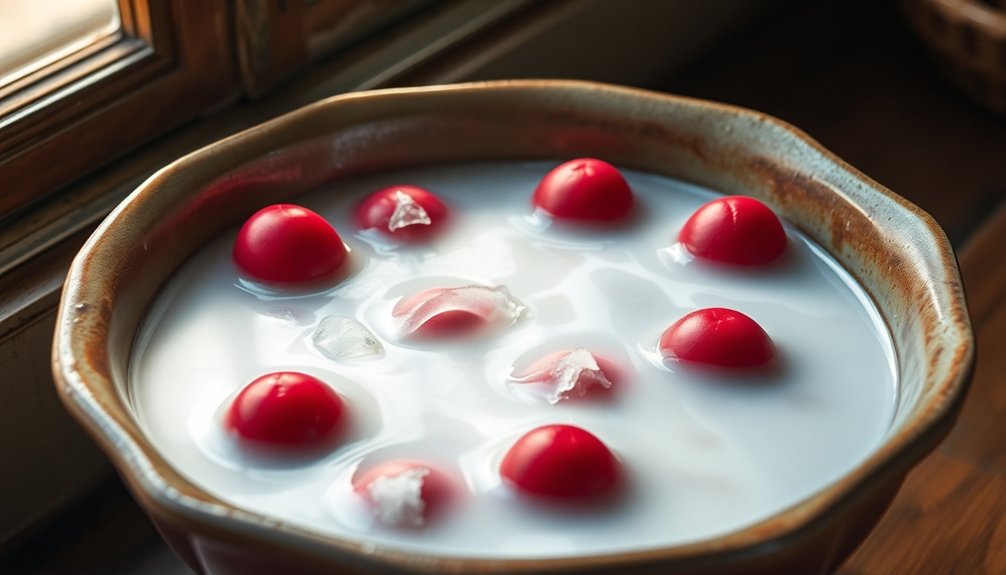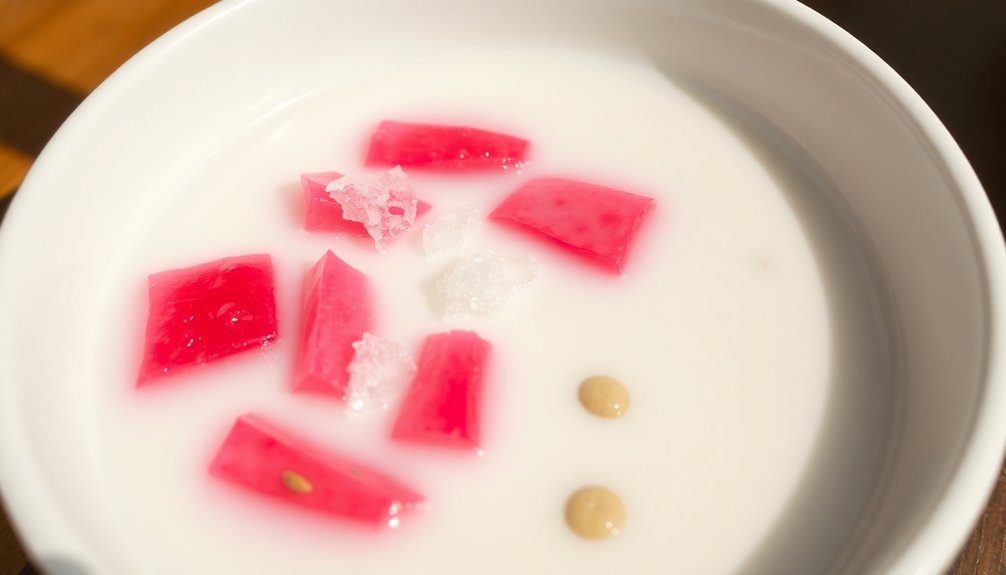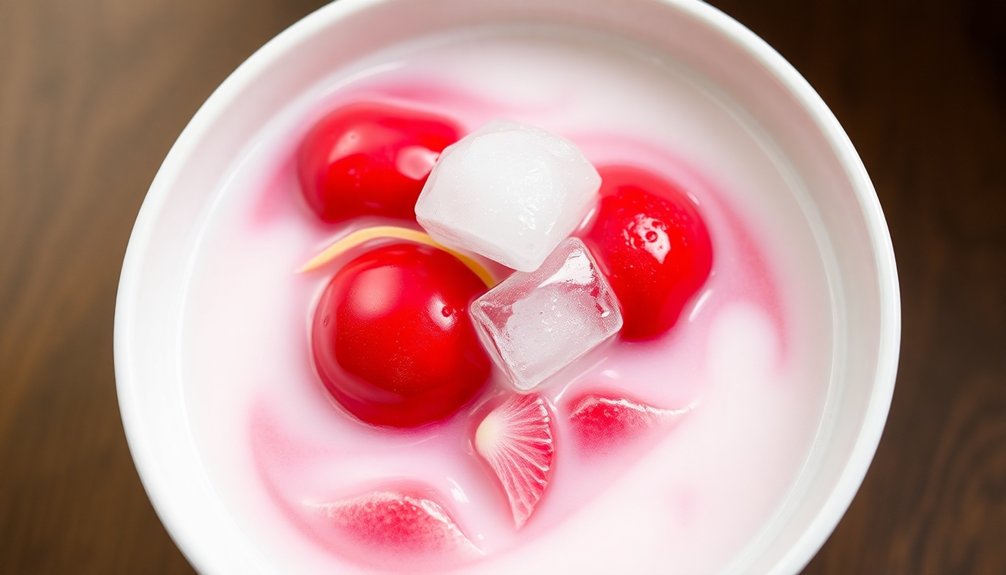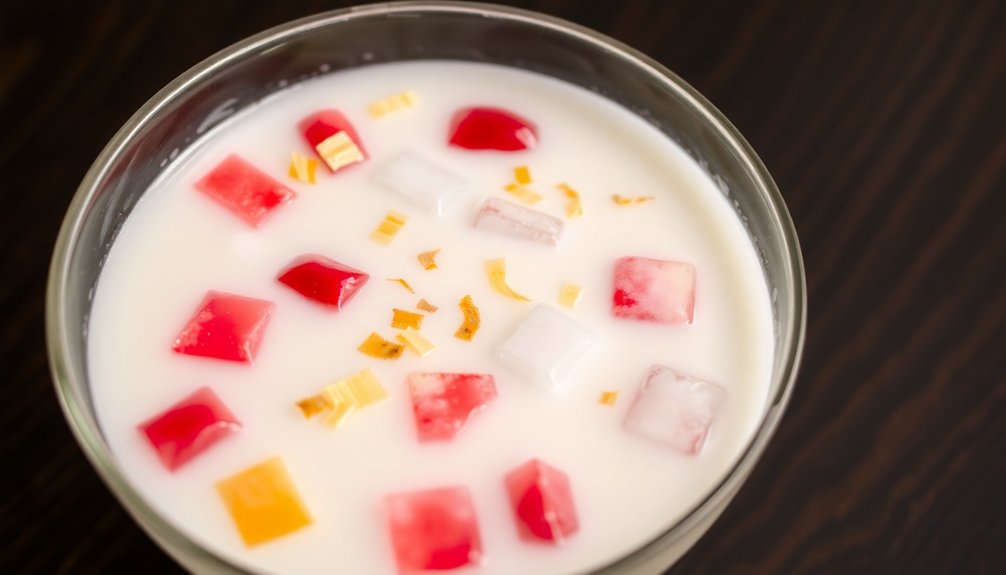Tub Tim Grob - Water Chestnuts in Coconut Milk
You'll love Tub Tim Grob, a beloved Thai dessert that transforms water chestnuts into glistening "rubies" nestled in creamy coconut milk. The chestnuts are soaked, boiled, and dyed red, creating a striking contrast against the sweet, chilled coconut syrup. Each spoonful offers an exciting mix of textures - crunchy water chestnuts and silky coconut milk. While it's perfect as an elegant dinner party finale, you'll discover why this mid-20th century creation remains a treasured Thai treat.
Key Takeaways
- Tub Tim Grob is a Thai dessert featuring water chestnuts in coconut milk, known for its distinctive "crispy rubies" appearance.
- Main ingredients include water chestnuts dyed red, coconut milk, sugar, salt, pandan leaves, and crushed ice.
- The dessert combines sweet, creamy coconut milk with crunchy water chestnuts, creating a delightful contrast in textures.
- Preparation involves soaking water chestnuts overnight, boiling them until tender, and serving with chilled coconut milk syrup.
- Traditionally served cold as a refreshing treat, often garnished with crushed ice and optional jackfruit for added flavor.
History

While the exact origins of Tub Tim Grob remain unclear, this vibrant Thai dessert emerged in the central region of Thailand during the mid-20th century.
You'll find that the name translates to "crispy rubies," referring to the water chestnuts' jewel-like appearance when coated in tapioca flour and colored red.
The dessert's cultural significance has grown substantially since its creation, becoming a staple at Thai festivals and special occasions.
You'll notice regional variations throughout Thailand, with some areas adding different fruits or adjusting the sweetness levels of the coconut milk.
In Bangkok, you'll often see street vendors preparing this dessert with their own signature touches, while upscale restaurants have begun offering modern interpretations of this beloved treat.
Recipe

Ingredients:
- Water chestnuts (fresh or canned)
- Red food coloring
- Pandan leaves
- Coconut milk
- Sugar
- Salt
- Crushed ice
- Jackfruit (optional)
Instructions:
- Peel and cube water chestnuts if using fresh ones.
- Soak water chestnuts in red food coloring for 30 minutes.
- Prepare syrup by boiling water with pandan leaves and sugar until dissolved, then let cool.
- Mix coconut milk with a pinch of salt and set aside.
- Drain the colored water chestnuts.
- Fill serving glasses with crushed ice.
- Add the red water chestnuts to the glasses.
- Pour the coconut milk mixture over the ice.
- Add the cooled pandan syrup.
- Top with jackfruit pieces if desired.
- Serve immediately with a spoon and straw.
Cooking Steps

You'll start by soaking the water chestnuts overnight to guarantee they're properly hydrated before boiling them until they reach a tender consistency.
Next, you'll add the ruby red coloring to achieve the signature jewel-like appearance, then prepare a sweet coconut milk syrup by combining coconut milk with sugar and a pinch of salt.
Finally, you'll assemble the dessert by placing the colored water chestnuts in serving bowls, pouring the coconut milk syrup over them, and chilling until ready to serve.
Step 1. Soak Water Chestnuts Overnight
To prepare water chestnuts for Tub Tim Grob, place them in a large bowl and cover completely with cold water.
You'll need to soak them overnight or for at least 8-12 hours at room temperature. This soaking process is essential as it helps soften the chestnuts and makes them more receptive to the red food coloring that gives Tub Tim Grob its distinctive appearance.
The soaking benefits go beyond just softening - it also enhances the chestnuts' natural sweetness and improves their overall texture.
You'll notice significant texture improvement after soaking, as the chestnuts become more tender while maintaining their signature crunch.
Make sure you've got enough water to fully submerge the chestnuts, as they may expand slightly during the soaking process.
Step 2. Boil Chestnuts Until Tender
Drain the soaked water chestnuts and transfer them to a medium-sized pot filled with fresh water.
Verify there's enough water to cover the chestnuts by at least an inch. Place the pot over medium-high heat and bring the water to a gentle boil.
Once boiling, reduce the heat to maintain a steady simmer. This tenderizing method guarantees the chestnuts cook evenly without becoming mushy.
You'll need to boil them for about 15-20 minutes, checking periodically with a fork to test their tenderness. The chestnuts are ready when they're soft enough to pierce easily but still maintain their shape.
Using these boiling techniques, you'll achieve the perfect texture - tender throughout but not falling apart.
Once done, drain the chestnuts in a colander and let them cool slightly before proceeding.
Step 3. Add Ruby Red Coloring
While the chestnuts are still slightly warm, pour a few drops of red food coloring over them in a mixing bowl.
You'll want to achieve that signature ruby red color that makes this Thai dessert so visually striking. Gently toss the chestnuts to guarantee even coating, being careful not to break them.
- Use natural red food coloring if possible, as it creates a more appetizing shade without any artificial aftertaste.
- Add the coloring gradually - you can always add more, but you can't remove excess color once it's absorbed.
- Let the colored chestnuts rest for 2-3 minutes to allow the color to set before proceeding with the dessert presentation.
The vibrant red hue of the water chestnuts creates a beautiful contrast against the pure white coconut milk, making this dessert visually memorable.
Step 4. Prepare Coconut Milk Syrup
The coconut milk syrup forms the creamy base that will embrace your ruby-colored water chestnuts.
In a medium saucepan, combine 2 cups of coconut milk with 1/2 cup of sugar and 1/4 teaspoon of salt. Heat the mixture over medium heat, stirring constantly until the sugar dissolves completely.
You'll notice the coconut milk benefits as it transforms into a silky, fragrant syrup. Let it simmer for 5 minutes until it thickens slightly, but don't let it boil.
For syrup variations, you can add pandan leaves or vanilla extract for extra depth. If you prefer a thicker consistency, mix 1 teaspoon of cornstarch with cold water and gradually stir it into the warm syrup.
Once ready, remove from heat and let it cool to room temperature.
Step 5. Combine and Serve Chilled
Once your coconut milk syrup has cooled completely, pour it into serving bowls or dessert glasses, then gently add your prepared red water chestnuts. This classic Thai chilled dessert is best enjoyed when properly assembled and served at the right temperature.
- Top your dessert with crushed ice to keep it extra cold and enhance the invigorating experience.
- Garnish with fresh pandan leaves or mint for an authentic presentation and aromatic touch.
- Serve immediately while the coconut milk is still cold and the water chestnuts maintain their crisp texture.
You'll find that Tub Tim Grob is one of Thailand's most beloved invigorating treats, especially during hot weather.
The contrast between the sweet, creamy coconut milk and the crunchy water chestnuts creates an irresistible combination that's both cooling and satisfying.
Cooking Tips

Making perfect Tub Tim Grob requires careful attention to temperature and timing during preparation. When cooking the water chestnuts in syrup, maintain medium heat and stir constantly to prevent sticking. You'll know they're done when they turn translucent with a slight pink hue. Don't overcook them, or they'll become mushy.
For the best cooking techniques, prepare the coconut milk mixture separately and chill it thoroughly before combining with the water chestnuts. The syrup should be thick enough to coat the back of a spoon but not overly sticky.
When it comes to flavor pairings, you can enhance the dessert by adding pandan extract or jackfruit pieces, but don't overpower the delicate coconut base. Keep your ingredients cold throughout the assembly process for ideal texture.
Final Thoughts

With proper preparation and attention to detail, Tub Tim Grob stands as one of Thailand's most beloved desserts, combining invigorating sweetness with unique textures.
You'll find its cultural significance deeply rooted in Thai cuisine, where it's served at both casual gatherings and formal celebrations.
- You can experiment with dessert variations by adding tropical fruits like jackfruit or lychee to create your own signature version.
- While the traditional recipe calls for water chestnuts, you'll discover that some modern interpretations include different root vegetables.
- You'll appreciate how this dessert has evolved across Thailand's regions while maintaining its essential character and charm.
Whether you're serving it at a dinner party or enjoying it as a revitalizing afternoon treat, Tub Tim Grob's delightful combination of flavors and textures won't disappoint.
Frequently Asked Questions
How Long Can Tub Tim Grob Be Stored in the Refrigerator?
You'll get the best storage life by keeping it refrigerated up to 3 days. After that, the coconut milk's texture changes and chestnuts soften. For ideal shelf life, store components separately.
Can I Substitute Water Chestnuts With Other Fruits or Vegetables?
Don't put all your eggs in one basket. You can experiment with alternative ingredients like crunchy jicama, crisp Asian pear, or firm lychees - though each brings different flavor profiles.
Why Does the Food Coloring Sometimes Not Stick to Water Chestnuts?
If you're having trouble with food coloring not sticking, it's likely because your water chestnuts are too wet. Always pat them completely dry and score their surface before applying the coloring.
Is Tub Tim Grob Served Hot or Cold?
You'll find this dessert served cold, and that's the preferred temperature. It's invigorating when chilled, especially since coconut milk and water chestnuts taste best when they're nice and cool.
Can I Use Canned Coconut Milk Instead of Fresh Coconut Milk?
Like choosing between Fiji's finest and bottled water, you can use canned coconut milk, though fresh offers more vibrant flavor and nutritional benefits. Both options work, but fresh delivers superior results.
